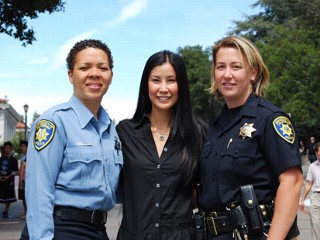Category: Uncategorized
Guest Blogger: Lisa Owens Viani of the San Francisco Estuary Partnership.
As sea level rises, and the climate changes, how will the San Francisco Bay Estuary and its wetlands, watersheds, and wildlife—including the ever-so-clever, charismatic Martinez beavers—respond? Sea—and Bay and Delta—levels—are predicted to rise as much as four and a half feet by the year 2100. One way of responding to this threat is to make our watersheds more resilient, or better able to withstand change. To do that, we need less hardscape—concrete and pavement—and more green, as in trees, shrubs, reeds, and rushes.
We need to slow, spread, and sink our stormwater runoff (to quote my friend Brock Dolman, of the Occidental Arts and Ecology Center) instead of shooting it straight into the Estuary; by slowing, spreading, and sinking all of that water, we replenish groundwater, reduce flashy runoff and erosion, filter pollutants, and create more resilient, more flexible watersheds. We can daylight creeks (dig up and bring those in pipes back above ground), revegetate the ones in concrete channels, open up and restore creek mouths where they enter the Bay in pipes, restore more wetlands—nature’s “sponges” and buffers against sea level rise—and create many more “green stormwater” projects. Beavers, too, could play a big part in a more resilient landscape, helping to recharge groundwater, slow flashy flood flows and stream bank erosion, and restore habitat for our threatened salmonids.
On September 29-October 1, 2009, the Estuary Partnership will examine some of these questions—and many more issues affecting the Estuary—during its 9th biennial State of the Estuary conference, entitled “Our Actions/Our Estuary.” In addition to keynote speakers from Stanford University, NOAA, and the Pacific Institute who will address climate change, other sessions at the conference will focus specifically on the status of the fish, birds, and other wildlife that use the Estuary, and the status of their habitat. On the second day, watershed restoration activities being promoted by cities surrounding the Bay will be highlighted. Featured cities include San Mateo, Emeryville, Hercules, and San Francisco. Guest speaker Tom Liptan, from Portland, will describe his city’s groundbreaking green stormwater projects, and the Ella Baker Center’s Jakada Imani will talk about how we can put people back to work again around the Bay through green jobs. Time Magazine’s Michael Grunwald gives the keynote address that day, sharing lessons learned in the Everglades.
On the third day, scientists and others will address new contaminants of concern in the Bay, how to retrofit our older urban and suburban landscapes in order to tackle water and air quality concerns, and how to deal with the trash epidemic in the Estuary and Pacific Ocean. We’ll learn about the latest efforts to restore subtidal (beneath the water) habitat in the Bay, and from a variety of environmental groups about how they are engaging local communities and students in their watersheds. Click here for the entire program or to register.
I promised i’d give a mention to this weekend’s Master Gardener Tour. Several of the garden’s have Martinez Addresses, and our local Master Gardeners have been good (though surprising!) friend of the Martinez Beavers. For 15 dollars you get the full benefit of their training and expertise, and some great ideas for your own backyard.
President Harriet Burt writes:
We are hoping that it is not our last as the County seed money funding (of about $3k) may be pulled which will stop $3m of UC Cooperative Extension money which funds us, 4-H, the County Ag advisors for the remaining real farmers, nutrition programs all sorts of good things for all residents in the County. We are fighting hard to keep it. Tickets cost $15 and can be obtained from me! (372-8038 or 209-0800 or email) and I will deliver! Six gardens including two neat ones in Martinez: The downtown one is on the top of Brown Street in one of the old Shell cottages right next to the refinery. Troy McGregor is an Australian who bought the place which is quite charming albeit small and has put in a wonderful garden of natives, mediterranean and Australian plants…low on water needs but high on appeal. The fun thing is that Marilyn Thelen’s step-grandfather worked for Shell and maintained the gardens on that block of residences built originally for Shell employees.
The one in Virginia Hills is a neat lawn-free walking garden….the 60s low maintenance foundation plants like camellias and nandina and juniper and the lawn have made way for drought tolerant and wonderfully laid out plants…You’ll enjoy all the gardens including two in Pleasant Hill and two in the Tice Valley part of Walnut Creek. One of those is truly amazing if you like vegetable gardening, it’s a must see! Actually it is anyway as the ornamental part is wonderful also. Our theme this year is water conservation so we are emphasizing native, Mediterranean and Australian plants. All the gardens have great features and all are emphasizing low water usage in some way including transitioning from a more traditional plant palette to one that acknowledges the growing scarcity of water.
We’re having a big plant sale at the other one — mostly drought tolerant plants such as salvias, succulents etc. And, fall is the best time to plant natives and Mediterranean plants so they get watered in well (or hopefully well if El Nino comes through).

This is what a hero looks like:
I don’t need to show you what a villain looks like: you’ve all seen the photo. Whatever you take from this horrific news story I hope you remember that the campus police at UC Berkeley can sniff out evil in 18 minutes that the city of Antioch has ignored for 18 years.







































